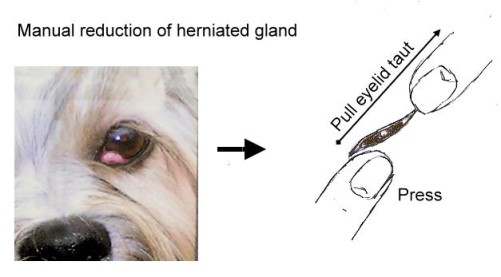Cherry Eye
Cherry Eye is an inflammation of the
Harderian Gland, an accessory
tear gland of the conjunctiva inside the lower eyelid. It
occurs
in eyes that have a poorly developed ligament holding the gland in
position.  The
gland is contained within a fold of conjuctiva commonly called the
"third
eyelid". Normally the lower pole of gland is anchored to the
connective tissue inside the bony orbital rim. In
the abnormal
eye, the inferior ligament is absent or poorly developed.
When the
gland becomes inflamed and swollen, it flips up from under the "third
eyelid" and herniates from under the lower eyelid, (see the figure
below.)
The
gland is contained within a fold of conjuctiva commonly called the
"third
eyelid". Normally the lower pole of gland is anchored to the
connective tissue inside the bony orbital rim. In
the abnormal
eye, the inferior ligament is absent or poorly developed.
When the
gland becomes inflamed and swollen, it flips up from under the "third
eyelid" and herniates from under the lower eyelid, (see the figure
below.)
Through repeated inflammation and
herniation, this condition
is associated with the development of "dry eye" or
kerato-conjunctivitis
sicca. Surgery can restore the gland to it's proper
position.
Removal of the gland can precipitate "dry eye" and so should
be avoided. Relatively small, almond shaped eyes whose
structures
are well supported by the infraorbital malar complex (cheekbones) are
rarely
subject to cherry eye. Breeders should select stock with
healthy
eye conformation, and prospective owners should look for a small almond
eye when purchasing a puppy.
 Occasionally
the
gland will swell and herniate acutely from allergy,
injury or infection. If your dog does develop a cherry eye, it is
important
to reduce it as soon as possible to avoid drying and further injury
which
can turn an acute herniation into a chronic one.
Occasionally
the
gland will swell and herniate acutely from allergy,
injury or infection. If your dog does develop a cherry eye, it is
important
to reduce it as soon as possible to avoid drying and further injury
which
can turn an acute herniation into a chronic one.
You can often replace the gland into it's
normal position under
the "third eyelid" membrane by a simple manual maneuver.
While
stretching the eyelid in a superior lateral direction, put gentle but
firm
pressure on the medial lower lid as indicated in the figure. This
maneuver
will generally work on cherry eyes that have been present for less than
24 hours, and are not very large or infected. Antibiotic drops should
be
used for about 48 hours following replacement of the gland.
 The
gland is contained within a fold of conjuctiva commonly called the
"third
eyelid". Normally the lower pole of gland is anchored to the
connective tissue inside the bony orbital rim. In
the abnormal
eye, the inferior ligament is absent or poorly developed.
When the
gland becomes inflamed and swollen, it flips up from under the "third
eyelid" and herniates from under the lower eyelid, (see the figure
below.)
The
gland is contained within a fold of conjuctiva commonly called the
"third
eyelid". Normally the lower pole of gland is anchored to the
connective tissue inside the bony orbital rim. In
the abnormal
eye, the inferior ligament is absent or poorly developed.
When the
gland becomes inflamed and swollen, it flips up from under the "third
eyelid" and herniates from under the lower eyelid, (see the figure
below.)  Occasionally
the
gland will swell and herniate acutely from allergy,
injury or infection. If your dog does develop a cherry eye, it is
important
to reduce it as soon as possible to avoid drying and further injury
which
can turn an acute herniation into a chronic one.
Occasionally
the
gland will swell and herniate acutely from allergy,
injury or infection. If your dog does develop a cherry eye, it is
important
to reduce it as soon as possible to avoid drying and further injury
which
can turn an acute herniation into a chronic one.